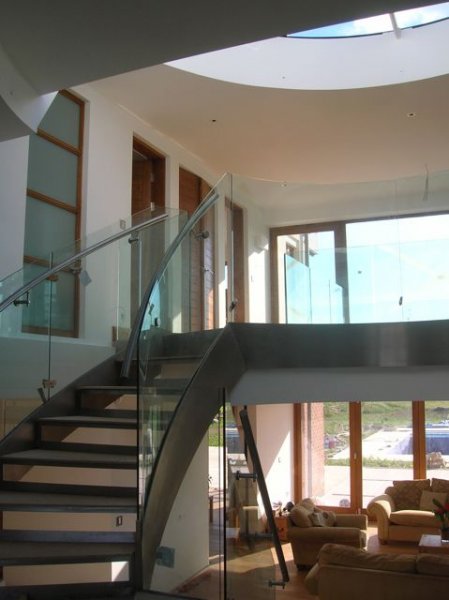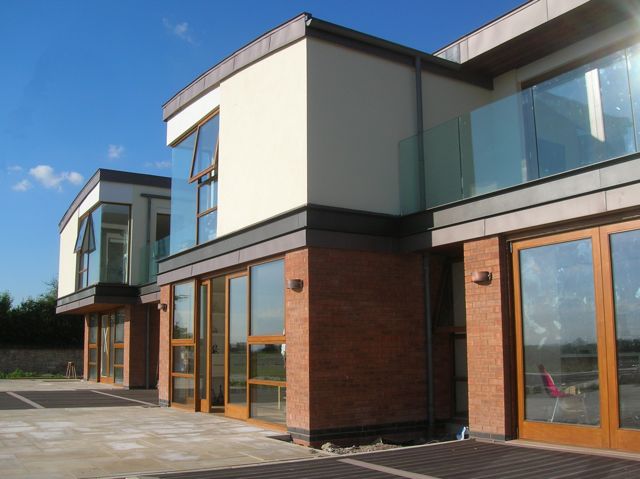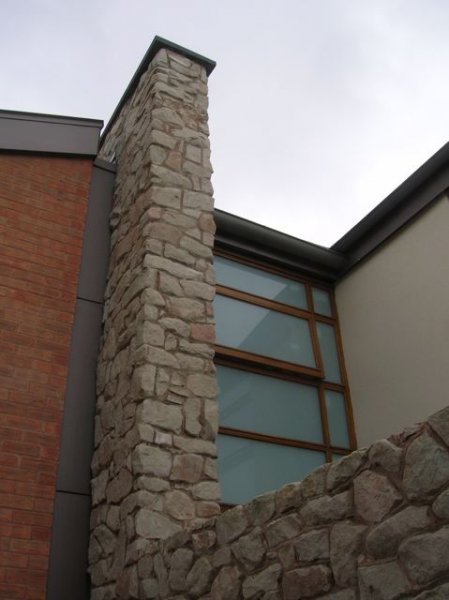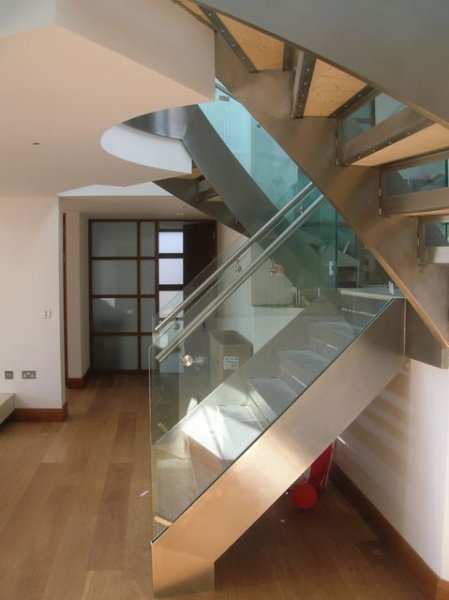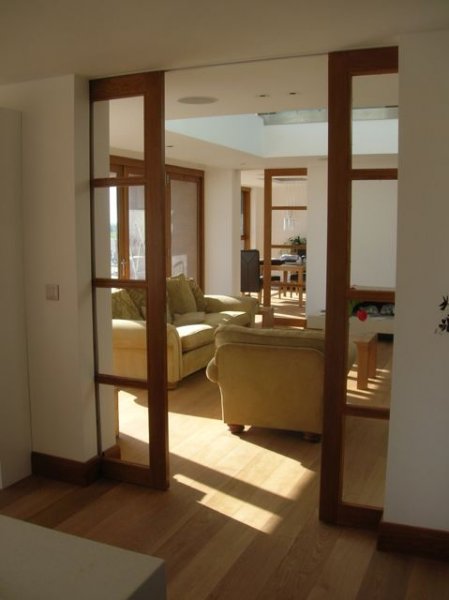Peripheral to the prescribed development boundary of the village of Inkberrow, Worcestershire, ‘Sunny Bank’ is a replacement dwelling built on the site of a former traditional two bedroomed 1950’s bungalow which incorporated an extensive paddock field behind the residential curtilage and a large detached workshop to the side. ‘Sunny Bank’ is our response to our Clients’ brief to create a five bedroomed open plan sustainable dwelling of contemporary style whilst still assimilating with the existing streetscape. Exploiting its elevated position, full advantage is taken of the Western aspect over open countryside with distant views of the Malvern Hills beyond.
Our Clients’ brief was to provide a five bedroomed open plan contemporary style residence capable of the flexibility that a family with three school aged boys is likely to place on it over the coming years. At inception, the site was occupied by a traditional two bed bungalow from the 1950’s sitting in a typically sizeable plot. An extant Outline Consent existed for an infil dwelling on land to the side of the existing bungalow, limited by Condition. Using the existing Consent and the existence of a sizeable detached outbuilding which already existed on the plot, taken to be ancillary to the existing dwelling, we gained support for the proposals in principle at pre-Application, the Planners embracing what they described as ‘cutting edge’; it was suggested at that time that the Outline Consent for an infil dwelling would need to be rescinded, but this was never later demanded. We were later further encouraged by the Planning Departments willingness to support a Change of Use Application for part of the paddock field to extend the residential amenity once the scale of the developed proposal was determined.
The design of the building evolved from the Clients brief with consideration for existing site constraints. The then extant permission for the infill bungalow, which was intended to sit adjacent the existing, had a Condition that the ridge height was not to exceed that of the existing bungalow so as to preserve distant views to the Malvern hills to the west for the slightly more elevated two storey houses opposite. Surprisingly this Condition was not appended to the final Permission under which the scheme was built, maybe because our Client had already decided to embrace this as a design criteria and this was demonstrated in the detail of the submitted scheme. Whilst this initially provided a massive design challenge on us, it ultimately assisted with the solution: With the site gently falling toward the west within the established residential curtilage, it was determined that a degree of excavation of the site could be undertaken to allow a reduced formation level; exercises were undertaken to determine how much needed to be removed in order to achieve a two storey building within the prescribed height constraint, with a ‘standard’ roof format this was determined at in excess of three metres and this was considered too onerous, with the effects of this dig extending all most the complete extent of the paddock to the west (which fortunately our Client also owned). We had already determined the solution would be of contemporary aesthetic, so we reduced the proposed dig to 1.65 metres which from an entry volume to the front allowed us to have half a floor up and half a floor down to provide us with two storeys sufficient to allow a 5 bedroomed house with sufficient proximity between functions without undue sprawl. The effect of a reduced lower ground floor level 1.65 metres lower on the adjoining paddock was far less severe and also allowed for all arisings to be completely dealt with on our Clients’ land without transport away from site, which from our point of view ticked a big box on the sustainability front. How now to reconcile the desire for a traditional bungalow appearance to the street whilst ‘concealing’ a two storey volume behind the line of excavation? Originally, to evolve an ‘organic’ plan form we had mulled on the idea of an inconsistent ‘dig’ line, so that it wouldn’t be immediately obvious which parts were one or two storey; this was soon to be rationalised to a defined straight line to provide us with a coherent solution to several problems: Springing up off the line of excavation we would build a ‘spine wall’ structure; we debated as to whether or not to have it ‘inhabited’, but eventually chose not, simply thickening it as a diaphragm structure so that its proportions ‘looked right’ (we were later to intrude into its thickness slightly in one area to make the spaces work, but don’t tell the purists!). The original concept would be that the wall would be constructed from the same material inside and out so that it acted as a familiar locator, this was however to change once construction commenced. The spine wall was designed to serve several purposes and therefore brought a coherence to the design; a marker, a locator, a backdrop for the bungalow style front presence to lean against making its share of the roof scape a proper monopitch, and also as an interstitiary zone between the style of the front and style of the rear, which whilst they share a common palette of materials are quite different in their approach, the front being more solid, defensive and traditional, the rear open, multiperforate and airy. These two styles also reflect the room structure of each zone; the streetscene of the traditional cellular house in the immediate area breaking down into open plan reflecting the fluidity of fields behind; the one protecting views in, the other exploiting views out. The spine wall was originally intended to be constructed from natural stone up to front dpc level, the stone emphasising the depth ‘won’ from the ground with brickwork rising above, echoing a common vernacular where many local farm buildings are brick built upon an apparent relatively high stone plinth. However, when excavation commenced, bedrock was reached well before the reduced level dig had been achieved; the Contractor was less than impressed having to pecker it out and progress slowed. Ironically we had been searching, thus far in vain, for an appropriate stone to use in the building; my Clients were adamant they were not going to use an imported material; we joked initially that they had plenty of stone back home. The stone as it was brought out of the ground was a rather unpleasant yellowy green colour and was saturated; as it dried out however, the colour became increasingly more acceptable to the point where a sample panel was built and the decision was made. Having such a wealth of the material to hand, free of charge virtually, tempered the Clients enthusiasm for the brick on stone plinth idea, and the instruction was given to build the complete wall out of the on site sourced stone. We had to change a lot of drawn detail to suit and we were not too enthusiastic to commence with, but now agree it has been a resounding success and could not be closer to my definition of sustainability.
It is all too easy to rely on symmetry when designing buildings, and with the required proximity of functions and arrangement of the bedrooms, all of which have an en-suite arranged around a central double height space centred on the axis of arrival, we couldn’t help at times to generate a certain symmetry it gives views the immediate wow factor that my Clients desired. We found ourselves having to design out the symmetry where we could and compensating for it with balance; the offset entrance and a recurrent feature of having all glazed corners were to take your eye away from the fundamental shape.
At the back of our minds had been the desire to create a random roofscape; ever conscious of the shallow depth available and also our Clients’ desire not to have too many flat roofs, we had seen shallow pitches falling in every direction with each volume below having its own roof and a clerestory device beneath the high end of the pitches. As it evolved however, we half achieved this with individual volumes below being separately expressed under shallow asymmetric barrel vaults, which as you guessed it helped to give re-emphasise to the overall strain against symmetry.

